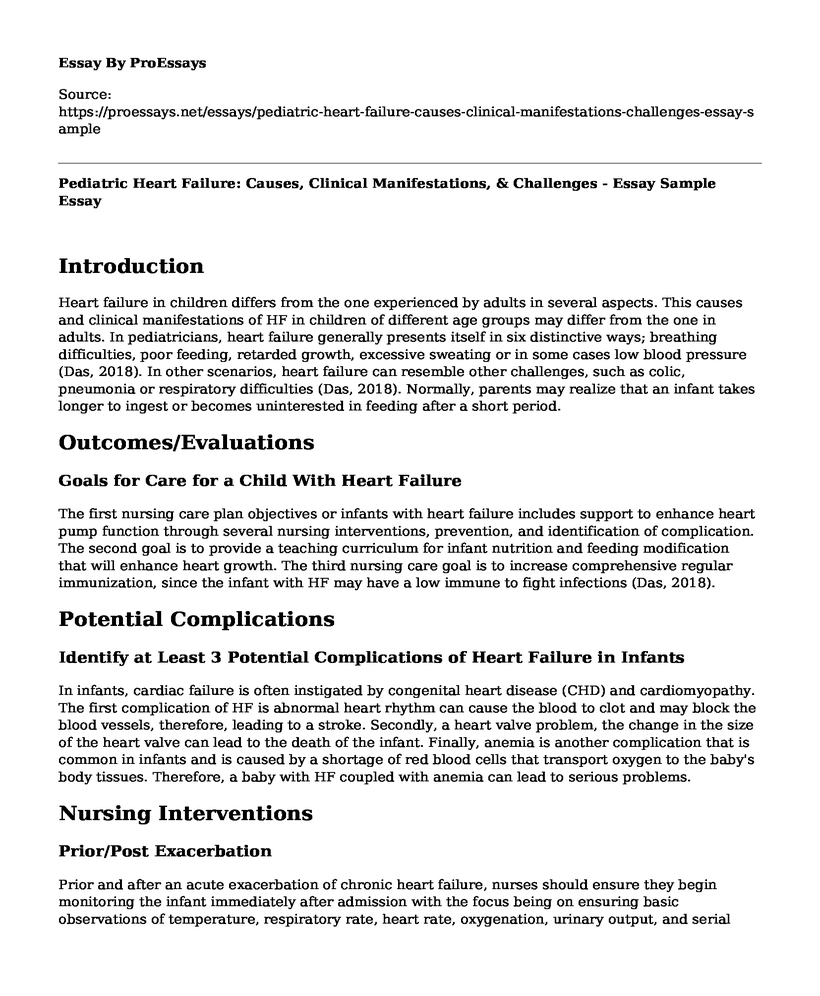Introduction
Heart failure in children differs from the one experienced by adults in several aspects. This causes and clinical manifestations of HF in children of different age groups may differ from the one in adults. In pediatricians, heart failure generally presents itself in six distinctive ways; breathing difficulties, poor feeding, retarded growth, excessive sweating or in some cases low blood pressure (Das, 2018). In other scenarios, heart failure can resemble other challenges, such as colic, pneumonia or respiratory difficulties (Das, 2018). Normally, parents may realize that an infant takes longer to ingest or becomes uninterested in feeding after a short period.
Outcomes/Evaluations
Goals for Care for a Child With Heart Failure
The first nursing care plan objectives or infants with heart failure includes support to enhance heart pump function through several nursing interventions, prevention, and identification of complication. The second goal is to provide a teaching curriculum for infant nutrition and feeding modification that will enhance heart growth. The third nursing care goal is to increase comprehensive regular immunization, since the infant with HF may have a low immune to fight infections (Das, 2018).
Potential Complications
Identify at Least 3 Potential Complications of Heart Failure in Infants
In infants, cardiac failure is often instigated by congenital heart disease (CHD) and cardiomyopathy. The first complication of HF is abnormal heart rhythm can cause the blood to clot and may block the blood vessels, therefore, leading to a stroke. Secondly, a heart valve problem, the change in the size of the heart valve can lead to the death of the infant. Finally, anemia is another complication that is common in infants and is caused by a shortage of red blood cells that transport oxygen to the baby's body tissues. Therefore, a baby with HF coupled with anemia can lead to serious problems.
Nursing Interventions
Prior/Post Exacerbation
Prior and after an acute exacerbation of chronic heart failure, nurses should ensure they begin monitoring the infant immediately after admission with the focus being on ensuring basic observations of temperature, respiratory rate, heart rate, oxygenation, urinary output, and serial ECGs are properly functioning (O'Donovan, 2011).
During Exacerbation
In this case, the focus of nurses may include instituting advanced monitoring of an infant that may include placement of invasive monitoring devices, such as an arterial line or breathing systems (O'Donovan, 2011). Hourly nursing evaluations are significant depending on the patient's clinical conditions, such as cardiovascular and respiratory analysis to stabilize the infant's heart rate, and decreased peripheral perfusion (O'Donovan, 2011).
Client Education
Identify 3 Teaching Points for the Child and Family
The first patient teaching should be on the precise diuretic to be given to the patient, and the underlying risks for augmenting or omitting a dose (Benbow, 2009). Nurses can teach parents to regularly monitor their child's weight to help assess the efficacy of their diuretics, and mostly the weight to be taken in the morning after the baby urinates, and before eating (Benbow, 2009). Nurses may teach parents to avoid fried foods or any feeds with 400 mg of sodium per serving for those with babies above the weaning stage, and importance for breastfeeding small infants instead of buying milk products from the market (Benbow, 2009).
Nursing Interventions
Identify 8 Nursing Interventions
To prevent further complications, the following nursing interventions have been outlined; shock management cardiac; it includes promotion of adequate tissue perfusion for an infant who is about to get severely compromised pumping function of the heart (Cavalcante et al., 2015). Circulatory care: through mechanical assist devices will involve providing transitory support of the circulation through the use of oxygenating devices to avoid an instance of stroke. Hemodynamic regulation will ensure the heart rhythm rate of an infant is stable (Cavalcante et al., 2015). Bleeding precautions and reduction will include a reduction of stimuli that may prompt hemorrhage in infants (Cavalcante et al., 2015).
For proper assessment, the following nursing care plans will be observed; monitoring electrolytes, weighing the infant daily, and maintaining a fluid-restricted diet will help curb fluid volume excess associated with HF (Nursing Care Plan n.d). Finally, hemodynamic regulation, preload, and afterload, and contractility will help normalize the cardiac output associated with cardiac anomaly (VSD) (Nursing Care Plan n.d).
References
Benbow, D. A. (2009). Heart failure: Educating your patient can help prevent readmission. Nursing, 5-7. https://pediatrics.aappublications.org/content/140/5/e20172607
Cavalcante, AMRZ, Brunori, EHFR, Lopes, CT, Silva, ABV, & Herdman, TH (2015). Nursing diagnoses and interventions for a child after cardiac surgery in an intensive care unit. Brazilian nursing journal, 68 (1), 155-160. http://www.scielo.br/pdf/reben/v68n1/0034-7167-reben-68-01-0155.pdf
Das, B. B. (2018). The current state of pediatric heart failure. Children, 5(7), 88. https://www.ncbi.nlm.nih.gov/pmc/articles/PMC6069285/
Nursing Care Plan. The child hospitalized with congestive heart failure. 1-2. https://wps.prenhall.com/wps/media/objects/354/362846/Child%20-%20Heart%20Failure.pdf
O'Donovan, K. (2011). Nursing care of acute and chronic heart failure. WIN Contin Educ, 19, 33-35. https://www.inmo.ie/tempDocs/CardioWINFeb_33.pdf
Cite this page
Pediatric Heart Failure: Causes, Clinical Manifestations, & Challenges - Essay Sample. (2023, May 10). Retrieved from https://proessays.net/essays/pediatric-heart-failure-causes-clinical-manifestations-challenges-essay-sample
If you are the original author of this essay and no longer wish to have it published on the ProEssays website, please click below to request its removal:
- Social Work Practice and Health Care Access Among Hispanic Immigrants
- Business Plan for Golden Hearts Senior Care
- U.S. Marijuana Use: Federal vs. State Laws - Research Paper
- Essay Sample on Appalachian Culture: Impact on Health & Wellbeing
- Coronavirus Crisis: US Government Slow to Respond Despite Wartime Measures - Essay Sample
- COVID-19: Impact of School Closures on U.S. Education System - Essay Sample
- Thesis Sample on Preventing CLABSIs: The Ideology Behind Psychiatric Nursing







